
by Alessia Leibert
September 2019
As hiring in manufacturing outpaces the number of applicants, employers are ramping up investments in training and retention strategies.
According to results from the 2019 Minnesota Hiring Difficulties Survey, 62 percent of job vacancies in skilled production occupations posted by manufacturing firms in 2018 were difficult to fill. The study identifies which skills are in need, other barriers besides lack of skills contributing to hiring difficulties, and which actions taken by employers were most effective at addressing the problems.
The first section of this article provides an overview of the magnitude and distribution of hiring difficulties. The second section takes a closer look at the nature and potential causes of hiring difficulties and, specifically, at the incidence of skills gaps. The third section looks at specific conditions under which hiring difficulties are most likely to arise. The fourth section explores what employers are doing to address hiring difficulties. The fifth section presents the methods preferred by employers to train their workforces, with the aim of pinpointing best practices for mitigating skills gaps. The final section provides a summary of findings from the survey and policy implications.
|
2019 Minnesota Hiring Difficulties Survey Design This study leverages spring 2018 Minnesota Job Vacancy Survey results. A subset of reported vacancies was selected for further study based on occupation and industry. For all selected vacancies, the research team made follow-up phone calls to employers to ask about their experiences filling these vacancies. In total, 146 establishments out of the 217 sampled responded to the follow-up survey, representing a 67 percent response rate and about 1,072 estimated vacancies.1 All the data cited in the article, including all graphs and tables, are from the 2019 Minnesota Hiring Difficulties Survey. 1Results and detailed methodology from previous rounds of the survey are available on DEED's website. Comprehensive information about the JVS methodology is available. |
Hiring difficulties varied widely by occupation. CNC Machine Tool Programmers had the highest incidence, at 96 percent, and Electrical/Electromechanical Engineering Technicians and Drafters had the lowest incidence, at 17 percent (Figure 1). The chart also shows median wage offers by occupation. These wages refer to 2018, and we heard from respondents that they have increased since then.
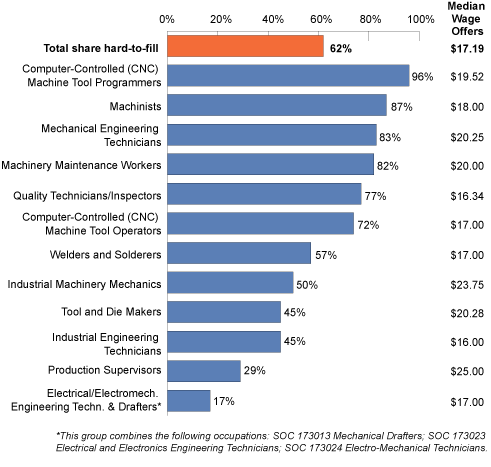
Seventy percent of the estimated vacancies in skilled production required only a high school diploma. Of these, 58 percent were difficult to fill, representing the largest pool of hard-to-fill vacancies in terms of sheer size (Figure 2). In terms of concentration, however, vacancies requiring a vocational certificate had the highest incidence of hiring difficulties at 77 percent. Vacancies requiring a four-year degree were both the smallest group and the least likely to be hard to fill (34 percent). These results show that, in general, the educational requirements of these jobs, alone, are not driving hiring difficulties.

Hiring difficulties also varied considerably by industry (Figure 3). One possible factor driving these differences is the technological intensity, or STEM-relatedness, of the industry.2 Non-STEM industries appear more prone to hiring difficulties, especially primary and fabricated metal products (81 percent hard to fill) and food, printing, and textile products manufacturing (70 percent hard to fill). In contrast, STEM sectors are less likely to experience hiring difficulties.
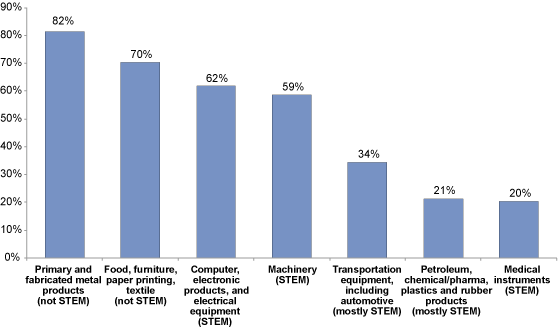
If too few applicants have the skills, knowledge, or experience to qualify for a position then we can say there is a gap, or mismatch, between workers' skills (supply) and the skills needed to perform the job (demand). On the other hand, there are a variety of reasons an employer may have difficulty hiring, and many of these have little to do with the available supply of qualified workers. Characteristics of the firm and/or the job itself could reduce the likelihood that candidates will choose to apply for or accept a position.
To determine how many cases of hiring difficulties are specifically attributable to skills mismatches, employers were asked to identify the reasons for their difficulties by choosing either:
Figure 4 summarizes employers' responses. Of the 62 percent of hard-to-fill vacancies, one-fourth (21 percent) were attributed exclusively to undesirable job characteristics or ineffective advertising strategies (demand-side factors), while 16 percent were attributed exclusively to a lack of skills, experience, or credentials in candidates (skills gaps). Sixty percent of hiring difficulties were perceived as being caused by a mix of skills gaps and demand-side factors. The remaining 3 percent was attributed primarily to applicants' lack of work ethic or lack of interest for a career in manufacturing.
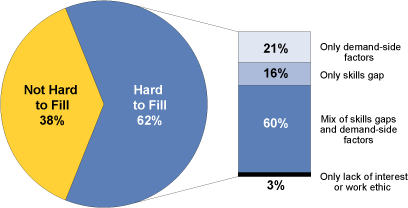
Pure skills mismatches – difficulties where employers did not also identify a demand-side problem – account for merely one-sixth of all hiring difficulties, or about 10 percent of vacancies in skilled production occupations.
When demand-side factors were cited as a problem, undesirable shifts and uncompetitive wages were the biggest barriers, affecting 49 percent and 40 percent of responses respectively, followed by location and ineffective advertising. The following quotes from respondents illustrate these points:
"If I had first-shift spots open, I'd be able to fill those."
"Our proximity to the Twin Cities metro area causes us to lose some applicants because we can't afford to pay what they are probably getting in the cities."
"When we find a person who is qualified we will hire them the next day. But these people have gone to competitors and they will take the best offer at other manufacturers. Maybe we aren't the best offer. "Maybe others offer more perks, a location closer to where they live, maybe a different shift, maybe hours that are more flexible, maybe they don't like the start time and the end time so they can take the kids to school in the morning and then come to work."
"We are in Eden Prairie. There is limited public transportation Monday through Friday and none on the weekends, and we are trying to hire a night shift and weekend shift."
"The work environment in our facility is not desirable because it is not air conditioned, not in a clean room, and workers need to stand. And the shift is 6 a.m. to 4:30 p.m."
"All we use is MinnesotaWorks and several temp agencies. We don't have active headhunters or recruiters. There is quite a bit that could be done to advertise, but we aren't doing. We are a relatively small company."
When skills mismatches were cited as a problem, two main issues emerged: inadequate hands-on training on the job and lack of a post-secondary credential. We found some evidence of gaps in post-secondary training offerings, specifically in tool making. The disappearance of vocational and technical training from high school is also a big concern. However, employers make it very clear that the skills they are looking for are groomed through years on the job. This means that, unless post-secondary training is tailored around the individual needs of employers, lack of experience could still be a barrier to hiring even if candidates have good educational credentials. Below are some illustrative comments from respondents:
"The products we make require very high-quality welding. It's not necessarily a certification or education, it is the quality of the weld they are able to perform that matters when we hire."
"What most applicants went to school for isn't really going to apply. Their knowledge at a competitor makes more sense because our system is not a common software."
"The quality control inspector job requires specialized experience more than any type of degree. The specialized experience is developed here as an operator. When we can't hire from within we want external candidates to have a minimum of over a year of experience."
"They have to troubleshoot and do a lot of diagnostic work on these machines, and we have over 200 machines. It takes someone very well rounded to get the machines up and running in a timely manner. It also takes a very independent worker."
"Local colleges used to have a program for tool and die making, but not anymore because people are not interested."
The need to hire someone with prior work experience inevitably restricts the size of the candidate pool and creates fierce competition among manufacturers for candidates.
In terms of skills set, by far the biggest gap identified in job applicants is general mechanical aptitude, sometimes as basic as the ability to use hand tools such as a drill or a screwdriver. Respondents characterized this gap as generational: younger generations have not grown up tinkering and fixing things as a hobby like older generations. An upcoming Trends article will provide more specific information on the skills and qualifications employers identified as most difficult to find.
We also asked employers whether the quantity of the job applications received played any role in their hiring difficulties. This problem impacted 68 percent of hiring difficulties. When a job opening did not draw enough applicants, 10 or fewer in most cases surveyed, the root causes are often traceable to undesirable job characteristics, or a combination of skills gaps and undesirable job characteristics. In a tight labor market, each aspect of the job can become a competitive factor in the talent race. As a result, firms that do not do enough to sweeten their offers or to highlight their advantages might draw fewer applicants. Here are some examples respondents provided:
"The pool of qualified candidates goes down significantly when the position is a second or third or weekend shift."
"There are so many more opportunities out there, and the work here is a bit dirtier. Also, we were looking for candidates with mechanical aptitude."
"You almost can't hire for maintenance mechanics. You have to grow and train them within. They need to have experience with industrial manufacturing equipment, conveyors, motors, and controls. More are aging out than coming into the field. Furthermore, the position we are trying to fill is the night shift, and we are located in a small community. We received only one application."
"We brought in an outside agency to help us with some advertising and rebranding a campaign for us because last fall we saw a drop in applicants."
To further add to the complexity of the hiring difficulties phenomenon, 52 percent of employers agreed that their difficulties could be related to candidates' lack of work ethic or interest. The examples cited by respondents included lack of interest in the work, low attendance often due to unwillingness to work a late shift, failure to pass a background check, and high wage expectations.
In today's tight labor market the supply of workers for production jobs has not kept pace with demand. However, survey results show that hiring difficulties cannot automatically be equated with a skills shortage. Augmenting the skill level of the workforce is only part of the solution in the absence of measures that also remove the barriers that employers themselves recognize as disincentives to apply for their positions.
In this section we analyze the impact of firm and job characteristics on hiring difficulties. Besides occupation and industry, mentioned in Figures 1 and 3, factors such as firm size, firm location, turnover, and the STEM-relatedness of an industry have the strongest effects on the probability of a vacancy being hard to fill (Table 1).
| Table 1. Comparison of Hard-to-Fill and Not Hard-to-Fill Vacancies by Firm and Job Characteristics | ||
|---|---|---|
| Factor | Categories | Percent Hard to Fill |
| Firm Location | Metro Area | 58% |
| Greater Minnesota | 65% | |
| Firm Size | Small: Less than 56 employees | 71% |
| Medium: 56-249 employees | 61% | |
| Large: 250 or more employees | 54% | |
| Experience Requirements | No experience required | 67% |
| Experience of less than three years | 60% | |
| More than three years of experience | 61% | |
| Education Requirements | High School diploma or less | 58% |
| Vocational certificate or Associate degree | 75% | |
| Bachelor's | 34% | |
| Training Indicator | Yes, the firm offered structured OJT or apprenticeship over the last 12 months | 56% |
| No, the firm did not offer structured OJT or apprenticeship | 76% | |
| Turnover Indicator | Yes, there was turnover in this position for reasons other than retirements | 76% |
| No, there was no turnover in this position except possibly because of retirements | 34% | |
| STEM-related Industry Indicator | Yes | 45% |
| No | 73% | |
| Position offers Retirement, Health Care, or PTO Benefits | Yes | 61% |
| No | 78% | |
| The regression model was able to correctly predict the presence (or absence) of a hiring difficulty in 88 percent of cases, with a Nagelkerke R Square of .680. The regression model is included in the full research report. | ||
The influence of each factor is explained below.
Firm location: Sixty-eight percent of production vacancies in Greater Minnesota were hard to fill compared with 58 percent in the Twin Cities. Distance from the metro area and rural versus urban location do not explain this difference. As shown in Figure 5, Central Minnesota – primarily urban and close to the Twin Cities – experienced significantly more hiring difficulties (95 percent) compared with rural Southwest Minnesota (59 percent). The explanation is probably that firms in Central Minnesota experience competition from both local and Twin Cities manufacturers.
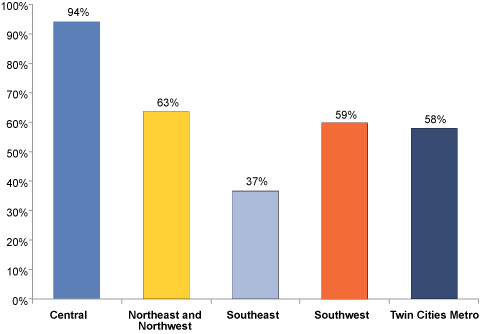
Firm size: Vacancies were more likely to be hard to fill in small firms (fewer than 56 employees) compared with medium and large firms (56 employees and over).
Delivery of on-the-job training (OJT): Seventy-six percent of firms that did not offer structured training had difficulties filling production vacancies compared with 56 percent that did offer training. A possible explanation is that firms that lack the capacity to deliver training to new hires also lack the flexibility to hire inexperienced candidates. The significance of this factor in reducing the likelihood of hiring difficulties persists even when all other characteristics listed in Table 1 are controlled for. Therefore, OJT emerges from this analysis as a potentially effective method to prevent hiring difficulties in a variety of contexts, including smaller-sized firms.
Education and experience level: Table 1 shows that hiring difficulties were more common in vacancies requiring a vocational certificate or associate degree (75 percent) followed by a high school diploma (58 percent). However, Figure 6 reveals that only 16 percent of hard-to-fill vacancies were truly entry-level, requiring no education and no experience. The largest group, 32 percent of hard-to-fill positions, needed more than one year of experience at a minimum. Employers seem to be responding to a tight labor market by lowering required education and substituting it with highly specific experience requirements.
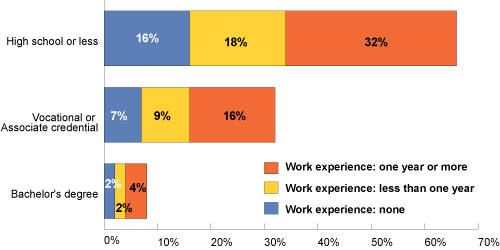
Expecting high-school educated candidates to bring a mid-level skill set, typically developed through technical post-secondary schooling or specialized on-the-job training, clearly presents a challenge for employers.
STEM-related industry: The incidence of hiring difficulties was higher in industries with low concentrations of STEM workers, at 73 percent, than in industries with high concentrations, at 45 percent. Employers' open-ended responses suggest that low-tech firms face competition from high-tech firms for talent, often for the simple reason that the "perceived coolness" of a product is a driver in deciding where to work. Despite the fact that many jobs in low-tech manufacturing have become just as technology-intensive as others in the industry, misconceptions can be hard to eradicate. Furthermore, this indicator probably captures differences in the physical comfort and safety of facilities. Employees in low-tech manufacturing might be exposed to uncomfortable temperatures, odors, dirt, or toxic substances depending on the industry.
Turnover: Three out of four vacancies in positions that had turnover were hard to fill, more than twice as high as among non-turnover vacancies at 34 percent. This could stem from the fact that firms with greater turnover need to do more hiring in general. Another explanation is that turnover and hiring difficulties share common causes. The most frequently cited causes of turnover are low wages, uncomfortable working conditions, undesirable work shifts, and lack of flexibility in work hours.
Benefits indicator: Vacancies that offered retirement, health care benefits or paid time off were less difficult to fill (61 percent hard to fill) than those that did not (78 percent hard to fill). Furthermore, all seasonal and temp positions were hard to fill, clearly demonstrating that job quality characteristics are important recruiting tools especially in tight labor markets.
In conclusion, we found measurable evidence of demand-side effects on hiring difficulties. In particular, the significance of turnover, benefits, and STEM-relatedness of an industry could indicate a causal relationship between undesirable job characteristics and recruiting problems. We also found a strong relationship between skills and hiring difficulties, demonstrating that skills gaps are present especially at the middle of the skills range. The variation in hiring difficulties across education requirements, occupation, industry and geographic location shows that one size does not fit all. Workforce development practitioners and policymakers must develop targeted interventions.
The practical steps taken by employers in response to hiring difficulties tell us a great deal about what they believe to be the nature of their challenges and the most effective solutions. Figure 7 shows that the most popular strategy, adopted in 61 percent of cases, is changing advertising or recruiting. Employers who chose this response felt that traditional advertising through job banks is not effective at reaching people already employed or who would not naturally think of manufacturing as a career. Today's tight labor markets require more innovative and broad-reaching strategies, such as Facebook campaigns or making connections with schools to promote these careers.
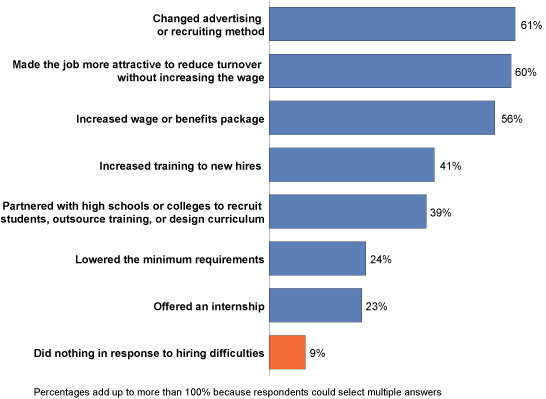
The second and third most popular strategies entail making the job more attractive with or without increasing the wage. These efforts include boosting benefits packages, offering more flexible and part-time work schedules, and creating opportunities for internal advancement. The following quotes give an idea of the variety of steps taken.
"Flexibility is a major benefit here, and this sets us apart from some of the other companies. We don't penalize people if their kids get sick or their car won't start. We offer flextime to make up the hours."
"We introduced paid parental leave and added sick leave separate from our vacation."
"We reduce mandatory overtime when we can to prevent turnover."
"We started giving our employees more opportunities to advance their skills by getting them on new product/new machines so they aren't doing the same machine or same parts every day."
Manufacturing provides a pay advantage compared to other sectors. The area where manufacturing has not kept pace is in work schedules, so adding flexibility can go a long way toward preventing recruiting and retention difficulties.
The fourth most frequent response, impacting 41 percent of hiring difficulties, is to increase training for new hires. As the labor market tightens and competition among firms for qualified workers increases, employers are clearly more willing to hire inexperienced candidates and then address their skills gaps internally, shifting from a "buying" to a "making" approach to skills formation. This option is also very well suited to address skills-related hiring difficulties. Here are some examples of actions taken by employers:
" [Machining and CNC Programming] require years of experience to become effective and efficient, so we have a small number of employees going through our apprenticeship program."
"We increased the training because we had to broaden our candidate pool by lowering the bar of the skills that we required. We've hired interns that have no work experience from high school, we've hired interns from the local college, we've hired people who are interested in welding and paid for their training."
"We couldn't find anybody. So we hired someone internally who was a Machinist, then hired someone to come in and train him so he could become a CNC Programmer."
"We had to drop the CNC experience and we have had to do our own training in-house in order to get candidates in the door. We also team up with two local colleges, and an instructor from the college comes in to train."
These examples show a high degree of awareness on the part of employers that offering training and promotion opportunities enhances their ability to hire and groom the specific skills needed.
Many respondents who do not provide OJT expressed the desire to take action but cited barriers such as the cost of delivering the training, lack of interest for the opportunities offered, and competition from other employers who "steal" workers who receive training.
"Most high schools do not offer vo-tech programs. Most tech colleges do not offer classes/programs for Tool Makers. A company could address the problem by hiring someone with a CNC degree and train them to make tools. We can't compete with them."
"I would pay for someone to take welding classes at the local technical college and I would also offer an apprenticeship program if anyone was interested in working for us, but there isn't anybody. I don't know what we can do for that other than immigration."
"When we get kids with post-secondary degrees we actually have to start training them from square one. They don't know the difference between a standard screwdriver and a Phillips. They expect us to teach them so in a couple of years they can go somewhere else with more experience for more money. I now understand why firms move to automation."
"Competitors like to steal my people because no one else is spending the time and effort to talk to high school kids and get them internships. And we actually spent time training our trainers so they could provide college-level applicable training on our equipment to those new hires. We do it ourselves hoping to retain them, but if they leave us for a competitor we become the best trainers for other companies."
This is a "tragedy of the commons" situation: the whole manufacturing sector would be more productive if every firm delivered internal training to broaden the pool of qualified workers, but individual companies believe they would be better off shifting the cost of training to their competitors. This perpetuates the problem by discouraging firms from devoting sufficient resources to building their pipeline internally.
The next most common strategy to overcome hiring difficulties involves partnering with local high schools or colleges, typically by recruiting on campus or offering student internships. Least common are partnerships around curriculum development. The reluctance to collaborate on curriculum design has many possible explanations. First, most critical competencies are firm-specific, often machine-specific, and not teachable outside of the company. Second, the technological landscape and the skills needed to harness new manufacturing technologies are evolving at an extremely rapid pace, making it hard for the educational system to keep up. Third, there is concern that working closely with schools will reveal too much about their technology to competitors or that applicants with a post-secondary credential will demand higher wages.
Whatever the underlying reasons, high schools and post-secondary schools are underutilized sources of new talent. The lack of cooperation with schools on what should be included in a well-rounded curriculum, both at the high school and post-secondary level, is likely to lead to dissatisfaction with the quality and quantity of applicants.
Other actions taken by employers include lowering requirements of the position (24 percent) and offering internships (23 percent).
One last strategy worth mentioning is making investments in automation to replace human labor in response to hiring difficulties. Of the occupations surveyed, CNC Machine Operators and Maintenance Technicians are less in demand because of automation. For example, one surveyed firm introduced robotic welding which increased productivity and eliminated the third shift, while another installed computer systems into machines so operators only need to punch keys. However, automation is not necessarily a job killer. It can lead to redesigning a role rather than eliminating it. For example, machining and CNC machining jobs are becoming more highly skilled, requiring an understanding of production methods and processes, programming, properties of materials, as well as strong problem-solving skills.
Most firms that averted hiring difficulties did so by promoting from within. This was achieved by building an internal pipeline of entry-level employees through methods that include enhancing internal training, adding internships or trainee positions to create a pool of pre-qualified candidates, and improving retention by developing career paths and increased employee engagement. Here is how one respondent described the multi-pronged approach:
"We have enhanced our training program, not with online training but with in-person, which is always the best and ensures that progress is being closely monitored. We have created job evaluations for all the machines here to help an employee learn. Our internal training lasts four to six months. We also partnered with schools: we offer a lab internship for college students to come and work here in the lab over the summer. We also have year-round mentoring and coaching because we want to help people succeed. Employees regularly meet with their supervisor or plant division manager. If someone needs coaching or help we follow up to let them know that we care. Follow up is so important. Probably one of the main reasons people leave is because they think no one cares. I would hope that no one here feels that way."
Finally, one employer found a solution to recruiting problems by hiring Somali and Liberian immigrants who are willing to work late shifts and can refer other people from the immigrant community to work for the company.
Given the importance employers attribute to skills learned on the job, this section documents what firms are currently doing to develop skills internally. These best practices can help employers bridge skills shortages before they turn into full-blown hiring difficulties. Figure 8 shows the types of training that employers reported delivering over the last 12 months, regardless of whether they experienced hiring difficulties.
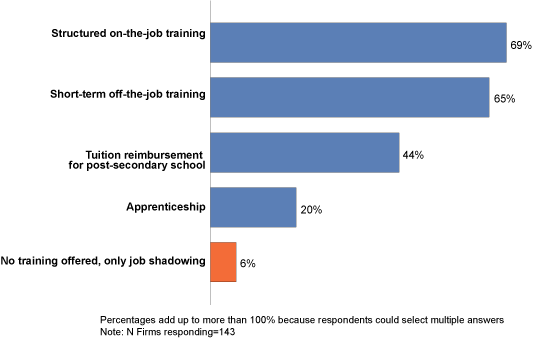
The most common type of training is formal in-house OJT. After deep cuts in training budgets during the Great Recession when skilled labor was abundant, employers have ramped up investments in their internal pipelines. However, the effectiveness of OJT also depends on its length and content. Length of training varies greatly, from two weeks to more than one year, and this variability likely leads to different outcomes. Apprenticeships, the longest and most structured form of workplace training, are offered only by 20 percent of respondents.
The second most common skill-building method, mentioned by two out of three surveyed firms (65 percent), is short-term off-the-job training, mostly for certifications in welding, forklift operator, and boiler operator, typically lasting less than two weeks.
Perhaps the most interesting trend is the share of firms, 44 percent, that offer college tuition reimbursement to their existing employees or new hires. The most comprehensive kinds of reimbursement cover tuition, books and tools. This opens up great opportunities for Minnesota youth to obtain a college credential debt-free and for firms to attract young people who otherwise could not afford to earn a degree or would not have thought of manufacturing as a career. Yet employers lament the fact that too few people take advantage of these incentives.
Only 6 percent of surveyed firms did not implement any of the strategies discussed here and relied exclusively on job shadowing or other very informal methods to train new hires.3 For most employers, the best practices for addressing talent shortages focus on a combination of internal and external training. In particular, 44 percent of firms offered both OJT and tuition reimbursement for post-secondary schooling. The most effective models are based on collaborations between educators, students and employers to provide classroom training and OJT at the same time (dual training). It is a win for all stakeholders: employers offer some tuition reimbursement or sponsorship in exchange for participants promising to work for the firm during the program and after graduation; participants obtain affordable college-level training and the guarantee of a job; and local colleges strengthen the quality of their instruction especially when employers provide the schools with the kinds of machines on which graduates will work.
The following quotes show the variety of initiatives and why employers believe them effective:
"Since we can't find the skills needed to be a technician, we have an internal apprenticeship program that will teach an operator to become a technician. We have a documented training process for that apprenticeship program that everybody goes through when they come onboard. For each machine there is a three- to six-month training process. For our entry-level technicians, we partner with a local college for basics on machines. We also offer tuition reimbursement for anything related to your job. Even if you are the guy that fixes machines and you want to take an accounting class, we are open to paying for it. Furthermore, we follow up regularly with our employees. Every hourly employee in our company gets a review every four months with their supervisor or manager. And we are good at promoting from within."
"Completion of our apprenticeship program typically requires three years, but credit is given for past work experience, allowing a participant to complete their apprenticeship in as little as one year. The key concept to apprenticeship is continuous learning throughout one's career, and this mindset has become pervasive through our workforce. I believe offering apprenticeships, on-the-job training, and tuition reimbursement has provided us with recognition in the employment market in our region and increased our applicant pool and contributed greatly to low turnover."
These comments also show that the commitment to workforce training can help create a culture of continuous learning, which is critical to success in manufacturing. Firms must be able to adapt to rapidly evolving technologies and customer needs. However, these approaches tend to be costly. It is not surprising that small firms are the least likely to offer OJT and tuition reimbursement. They are also least likely to have the organizational capacity to identify training gaps as they emerge, train the trainers, and offer mentorship and career growth opportunities. These firms are the most vulnerable to talent shortages because they have the fewest resources to address them.
Based on in-depth interviews with Minnesota manufacturing employers on 1,072 job vacancies in skilled production occupations, the major findings of this study are summarized below.
These findings reinforce what stakeholders have known for years: The pipeline problem lies at the root of hiring difficulties in manufacturing. Lack of student interest discourages post-secondary institutions from offering more classes in these fields. High turnover and employee poaching discourage firms from investing in OJT and deprive them of internal candidates to promote. As talent is lost to retirements, the capacity to provide good quality training diminishes. Finally, and just as important, high schools and post-secondary schools are still underutilized sources of new talent, reducing the chances of building the pipeline fast enough to offset retirements. Disincentives to employer-provided training can cause an overall decline in workforce skills across the sector.
Minnesota employers are investing in solutions that can solve the pipeline problem in its various forms. Demand factors are more often acknowledged and addressed, and firms are shifting from a strategy of buying skills from outside to building skills internally by training incumbent and new workers. The supply-side problem cannot be solved with increasing graduation rates post-secondary programs alone, but rather with a coordinated set of interventions at different levels of the workforce system, including the following:
While the challenges outlined in this article and resulting recommendations have been known and discussed for years, finding practical ways to implement and fund effective solutions is still a huge challenge. As technology advances, many of the careers highlighted in this study will require even higher skilled workers. If more job seekers, especially youth, get early exposure to these fields, they will likely see them as pathways to good paying jobs, and a renewed interest in skilled production could emerge as a result.
2The Bureau of Labor Statistics (BLS) defines high-tech industries as those having high concentrations of workers in science, technology, engineering, and mathematics (STEM) occupations. Our definition also includes industries with a high level of spending in research and development.
3Job shadowing typically lasts only two weeks and involves pairing up the new hire with an experienced worker who is not officially tasked with training. On-the-job training lasts longer, is more formal, and involves a trainer-trainee relationship to build a broad set of competencies.